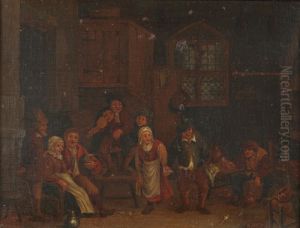Egbert Heemskerk Paintings
Egbert Heemskerk, also known as Egbert van Heemskerck or Egbert Heemskerk the Elder to distinguish him from his son, was a Dutch Golden Age painter, born in Haarlem in the Netherlands in 1634. Heemskerk is primarily known for his genre scenes, often with a humorous or moralizing tone, which depict lively tavern scenes, quack doctors, and alchemists. His style was influenced by the works of Adriaen Brouwer and Adriaen van Ostade, artists who were also known for their depictions of peasant life.
Heemskerk's early work suggested that he received his initial training in Haarlem, but he later moved to London around 1660. In England, he found patronage and continued his career, which was marked by a distinctive style characterized by a vivid use of color and a keen eye for the absurd and the comical in everyday life. His works often reflected the tastes and social concerns of the middle class of his time.
Not much is documented about Heemskerk's personal life, including the details of his training and his transition from the Netherlands to England. Nonetheless, his paintings have been well-preserved and continue to be of interest for their detailed depiction of 17th-century life.
Heemskerk's legacy includes a significant number of artworks that provide insight into the cultural and social dynamics of the period. He also left behind a son, Egbert Heemskerk II (also known as the Younger), who became a painter in his own right and often depicted similar subjects. Heemskerk the Elder died in London in 1704, leaving behind a body of work that continues to be appreciated for its humor, detail, and historical value.
